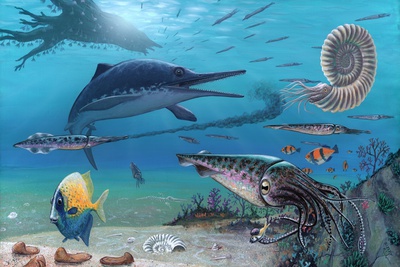Benson, Thor. 11 January 2015. “Fossils of Large Ocean Reptile Discovered on the Coast of Scotland.” UPI > Science News. Retrieved July 20, 2015.
- Available @ http://www.upi.com/Science_News/2015/01/11/Fossils-of-large-ocean-reptile-discovered-on-the-coast-of-Scotland/2871421023575/
Bressan, David. 14 October 2010. "Geology History in Caricatures: Exploring and Educating Geohistory." History of Geology.
- Available at: http://historyofgeology.fieldofscience.com/2010/10/geology-history-in-caricatures.html
Brusatte, Stephen. 12 January 2015. “How We Found Scotland’s First Jurassic Sea Reptile (And No, She’s Not Related to Nessie).” The Conversation > Science + Technology. Retrieved July 20, 2015.
- Available @ https://theconversation.com/how-we-found-scotlands-first-jurassic-sea-reptile-and-no-shes-not-related-to-nessie-36165
Brusatte, Steve. 18 January 2015. “Huge Honour to Meet Brian Shawcross Today. The Man Who Found Dearcmhara and Donated it to the Hunterian Museum.” Twitter. Retrieved July 20, 2015.
- Available @ https://twitter.com/stevebrusatte/status/556791039760273408
Brusatte, Stephen L.; Young, Mark T.; Challands, Thomas J.; Clark, Neil D.L.; Fischer, Valentin; Fraser, Nicholas C.; Liston, Jeff J.; MacFadyen, Colin C.J.; Ross, Dugald A.; Walsh, Stig; and Wilkinson, Mark. 2015. “Ichthyosaurs from the Jurassic of Skye, Scotland.” Scottish Journal of Geology.
- Available @ doi: 10.1144/sjg2014-018
Buckland, Francis T. Curiosities of Natural History. First Series. London: Macmillan and Co., Ltd; New York: The Macmillan Company, 1903.
- Available at: https://wellcomecollection.org/works/tf8hz95u/
Connor, Steve. 12 January 2015. “First Remains of New ‘Shark-like Reptile’ Found on the Isle of Skye.” The Independent > News > Science. Retrieved July 20, 2015.
- Available @ http://www.independent.co.uk/news/science/first-remains-of-new-sharklike-reptile-found-on-the-isle-of-skye-9971244.html
Dunham, Will. 11 January 2015. “Move Over Nessie, Scotland Gets a New Prehistoric Marine Reptile.” Thomson Reuters > Science. Retrieved July 20, 2015.
- Available @ http://www.reuters.com/article/2015/01/12/us-science-reptile-idUSKBN0KL00520150112
Hilton, Lucy; and von Radowitz, John. 12 January 2015. “Loch Ness Monster’s Long Lost Relative Discovered in Scotland and It Grew up to 14ft Long.” Mirror > News > UK News. Retrieved July 20, 2015.
- Available @ http://www.mirror.co.uk/news/uk-news/loch-ness-monsters-long-lost-4958101
Knapton, Sarah. 12 January 2015. “Was This Nessie’s Ancestor? Giant Prehistoric Monster Roamed Scottish Waters.” The Telegraph > News > Science > Science News. Retrieved July 20, 2015.
- Available @ http://www.telegraph.co.uk/news/science/science-news/11338263/Was-this-Nessies-ancestor-Giant-prehistoric-monster-roamed-Scottish-waters.html
Sample, Ian. 11 January 2015. Amended 16 January 2015. “Fossil from Skye Is New species of Marine Predator, Scientists Say.” The Guardian > UK News. Retrieved July 20, 2015.
- Available @ http://www.theguardian.com/uk-news/2015/jan/12/fossil-skye-new-species-marine-predator
Sugden, Maureen. 11 January 2015. “Found, Nessie’s Long-lost Cousin: Dolphin-like Reptile Lived 170million Years ago in Seas Around What Is Now the Isle of Skye.” Daily Mail > News. Retrieved July 20, 2015.
- Available @ http://www.dailymail.co.uk/news/article-2905908/Found-Nessie-s-long-lost-cousin-Dolphin-like-reptile-lived-170million-years-ago-seas-Isle-Skye.html
Watts, Jack. 12 January 2015. Updated 30 January 2015. “Long Lost Relative of Loch Ness Monster Discovered off the Isle of Skye.” Express > News > UK. Retrieved July 20, 2015.
- Available @ http://www.express.co.uk/news/uk/551424/Scientists-discover-relative-Loch-Ness-Monster-Isle-Skye














 Are Hawaiian Huakai Po Nightmarchers Avenging Halloween Thursday?on 10/02/2024
Are Hawaiian Huakai Po Nightmarchers Avenging Halloween Thursday?on 10/02/2024
 Mailing Addresses for 2023 Form 4868 Extending 1040 and 1040SR April 15, 2024, Due Dateon 04/15/2024
Mailing Addresses for 2023 Form 4868 Extending 1040 and 1040SR April 15, 2024, Due Dateon 04/15/2024
 Mailing Addresses for 2023 Forms 1040 and 1040SR Filed in 2024on 04/15/2024
Mailing Addresses for 2023 Forms 1040 and 1040SR Filed in 2024on 04/15/2024
 Mailing Addresses for 2022 Form 4868 Extending 1040 and 1040SR April 18, 2023, Due Dateon 04/13/2023
Mailing Addresses for 2022 Form 4868 Extending 1040 and 1040SR April 18, 2023, Due Dateon 04/13/2023



Comments
Thank you for visiting, WriterArtist!
Me too, it amazes me that the blue planet experienced such a giant-creature rule that managed to work alongside mini-lizard species. It's somewhat of a wonder to me that gigantic dinosaurs heavy-footed around without changing earthly revolutions and rotations!
It is amazing that earth was ruled by these giant creatures. It is also interesting to note that gigantic Dinosaurs share ancestry with such mini species of lizards. One can only visualize how enormous they would be with the size of the fossils. Clearly a lot of research has gone in identifying the Jurassic era creatures.
CruiseReady, Shawcross's marine lizard certainly inspires a lot of interesting comments and observations, as evidenced by your thoughts and those of blackspanielgallery. Dr. Brusatte -- who was involved in the specimen's identification and its discoverer's recognition -- is hopeful that other collectors will help complete the critter's information -- which is based only on a handful of critical bones -- by bringing forth other fossils.
It certainly is intriguing that Dearcmhara shawcrossi straddles the line between marine mammal and reptile by being compared on the one hand to dolphins and sharks and on the other to crocodiles and lizards!
blackspanielgallery, Shawcross's marine lizard indeed is such an educationally entertaining look into ancient Earth's animal life. It must be so heartwarming to Brian Shawcross to live to see his fossils categorized and serve as such a boon to reconstructing our planet's pre-history.
What an interesting creature! I find myself wondering if it wasn't a marine mammal, since today's marine lizzards are , and because it is mentioned as possibly 'dolphin-like.'
Quite a nice look into the distant past.